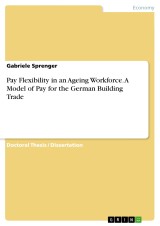Details

Pay Flexibility in an Ageing Workforce. A Model of Pay for the German Building Trade
1. Auflage
|
39,99 € |
|
| Verlag: | Grin Verlag |
| Format: | |
| Veröffentl.: | 03.08.2020 |
| ISBN/EAN: | 9783346217912 |
| Sprache: | englisch |
| Anzahl Seiten: | 244 |
Dieses eBook erhalten Sie ohne Kopierschutz.
Beschreibungen
Doctoral Thesis / Dissertation from the year 2018 in the subject Economics - Monetary theory and policy, grade: keine, University of Gloucestershire, language: English, abstract: Starting from the demographic change, the average age of work team members in the German building trade is expected to increase in the following decades. The findings of this study show that the performance of work teams also change due to a higher average age in organizations.
The changes are not uniformly positive or negative; sometimes they are even contradictory. Some relevant theories and models demonstrate that performance and pay are in a causal relationship. They affect each other or are in mutual dependence. The data analysis of the expert interviews and focus groups carried out in twelve different business types from the building trade has revealed that a change in performance does not trigger necessarily an adaptation in pay. An adaptation of pay could prove if it reduces or compensates a possible negative impact of a higher average age on team performance in work teams. The Four-dimensions-model of pay flexibility which is developed by the researcher based on the results and the findings of this study identifies the different fields of action distributed on four dimensions.
The model is based on the current pay conditions of the German building trade and represents a new approach to pay. It has been worked out that pay flexibility can be expanded based on the existing conditions and has to be built up on new structures which consider the demographic change. The model is broadly set up and takes into account the individual and contractual as well as collective and market-oriented dimensions. As the German building trade is traditionally not a pioneer in future-oriented change processes it is a challenge to implement the Four-dimensions-model of pay flexibility in this trade. The establishment of the model in practice aims to preserve the competitiveness and increases the attractiveness of the occupations in the trade, in order to counteract the shortage of skilled workers.
The changes are not uniformly positive or negative; sometimes they are even contradictory. Some relevant theories and models demonstrate that performance and pay are in a causal relationship. They affect each other or are in mutual dependence. The data analysis of the expert interviews and focus groups carried out in twelve different business types from the building trade has revealed that a change in performance does not trigger necessarily an adaptation in pay. An adaptation of pay could prove if it reduces or compensates a possible negative impact of a higher average age on team performance in work teams. The Four-dimensions-model of pay flexibility which is developed by the researcher based on the results and the findings of this study identifies the different fields of action distributed on four dimensions.
The model is based on the current pay conditions of the German building trade and represents a new approach to pay. It has been worked out that pay flexibility can be expanded based on the existing conditions and has to be built up on new structures which consider the demographic change. The model is broadly set up and takes into account the individual and contractual as well as collective and market-oriented dimensions. As the German building trade is traditionally not a pioneer in future-oriented change processes it is a challenge to implement the Four-dimensions-model of pay flexibility in this trade. The establishment of the model in practice aims to preserve the competitiveness and increases the attractiveness of the occupations in the trade, in order to counteract the shortage of skilled workers.
Diese Produkte könnten Sie auch interessieren:

Die globale Finanzkrise. Löste der folgende Kreditabschwung eine Deglobalisierung aus?

von: Constanze Krasselt

18,99 €















